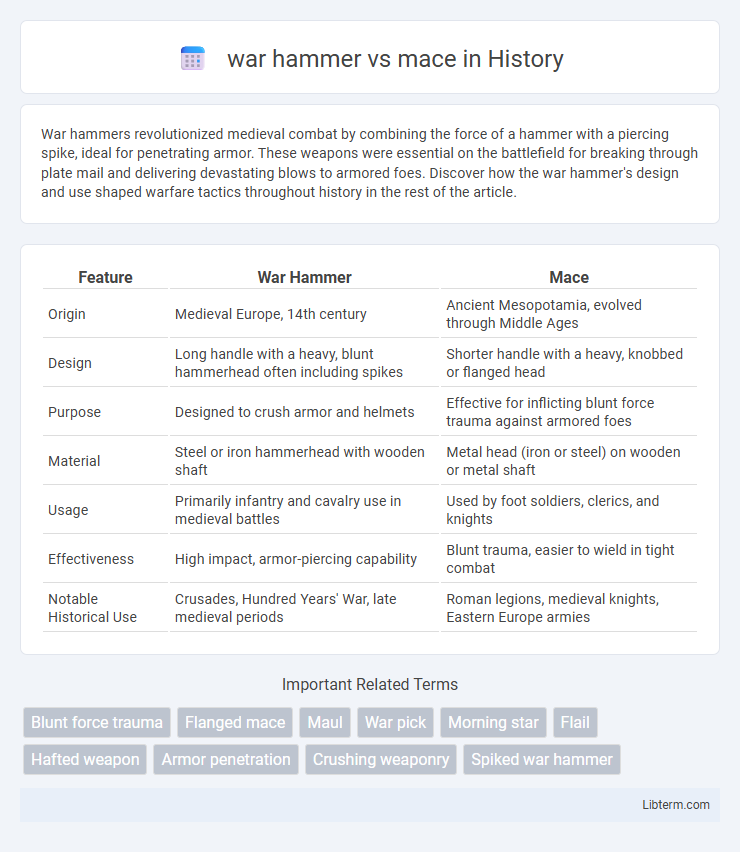War hammers revolutionized medieval combat by combining the force of a hammer with a piercing spike, ideal for penetrating armor. These weapons were essential on the battlefield for breaking through plate mail and delivering devastating blows to armored foes. Discover how the war hammer's design and use shaped warfare tactics throughout history in the rest of the article.
Table of Comparison
| Feature | War Hammer | Mace |
|---|---|---|
| Origin | Medieval Europe, 14th century | Ancient Mesopotamia, evolved through Middle Ages |
| Design | Long handle with a heavy, blunt hammerhead often including spikes | Shorter handle with a heavy, knobbed or flanged head |
| Purpose | Designed to crush armor and helmets | Effective for inflicting blunt force trauma against armored foes |
| Material | Steel or iron hammerhead with wooden shaft | Metal head (iron or steel) on wooden or metal shaft |
| Usage | Primarily infantry and cavalry use in medieval battles | Used by foot soldiers, clerics, and knights |
| Effectiveness | High impact, armor-piercing capability | Blunt trauma, easier to wield in tight combat |
| Notable Historical Use | Crusades, Hundred Years' War, late medieval periods | Roman legions, medieval knights, Eastern Europe armies |
Introduction: War Hammer vs Mace
War hammers and maces are medieval melee weapons designed for crushing armor and causing blunt trauma on the battlefield. War hammers typically feature a long handle with a hammerhead and sometimes a spike, delivering concentrated force to puncture or dent armor. Maces have a shorter shaft with a heavy, often flanged or knobbed head, optimized for bludgeoning opponents and breaking bones through armor.
Historical Origins and Development
The war hammer originated in medieval Europe as a response to armored opponents, featuring a hammerhead designed to crush plate armor and deliver concussive blows. In contrast, the mace dates back to ancient Mesopotamia and Egypt, evolving from simple wooden clubs into metal-headed weapons intended to inflict blunt trauma through armor. Both weapons developed alongside advances in armor technology, with the war hammer gaining prominence in the 14th and 15th centuries during the Late Middle Ages and the mace maintaining widespread use from antiquity through the Renaissance.
Key Design Differences
War hammers feature a compact, hammer-like head with a flat or slightly curved surface designed for crushing armor, often paired with a spike for penetration. Maces have a heavier, blunt striking head that is typically rounded or flanged, intended to deliver powerful, concussive blows effective against armored opponents. The war hammer emphasizes focused impact and armor penetration, while the mace prioritizes blunt force trauma over a broader impact area.
Materials and Construction
War hammers typically feature heads made from hardened steel or forged iron, designed for maximum impact and durability, while the shaft is often constructed from sturdy hardwood or reinforced metal for better control. Maces consist of a solid steel or iron head with flanged or knobbed designs to concentrate force, attached to a wooden or metal handle that provides balance and maneuverability. Both weapons rely on metallurgy techniques that enhance hardness and resilience, with war hammers focusing on shock absorption and maces on delivering crushing blows through weighted construction.
Combat Techniques and Usage
War hammers excel in delivering powerful, concentrated strikes designed to penetrate armor and cause blunt force trauma, making them effective in close-quarters combat against heavily armored foes. Combat techniques for war hammer users emphasize quick, precise swings combined with tactical strikes to joints or helmets to maximize damage. Maces rely on broad, crushing blows generated through rotational force, favoring techniques that involve heavy overhead or side swings intended to incapacitate opponents by breaking bones or denting armor.
Advantages of War Hammers
War hammers offer superior impact force by concentrating kinetic energy onto a small striking surface, making them highly effective against armored opponents. Their weight distribution allows for faster swings compared to maces, increasing the chances of a decisive blow. The war hammer's spike or pick attachment enhances versatility, enabling it to penetrate chainmail and plate armor more efficiently than the blunt head of a mace.
Strengths of the Mace
The mace excels in delivering powerful blunt force trauma, making it highly effective against armored opponents by concentrating impact energy to crush helmets and plate armor. Its simple construction allows for quicker, more robust attacks with less risk of weapon damage compared to edged weapons. The mace's ability to incapacitate through concussive strikes provides a strategic advantage in close-quarters combat where cutting weapons may fail.
Effectiveness Against Armor
War hammers excel in delivering concentrated impact force capable of denting or piercing heavy armor, making them highly effective against plate mail and helmets. Maces rely on blunt trauma to cause internal injuries even when armor is intact but may struggle to penetrate or deform thicker, well-crafted armor. War hammers' spike or flanged designs increase their armor-piercing capabilities, whereas maces generally prioritize crushing damage over penetration.
Cultural and Battlefield Significance
War hammers and maces both held significant cultural and battlefield roles throughout history, symbolizing power and martial prowess in medieval Europe. War hammers were especially valued for their ability to penetrate armor, reflecting advancements in metallurgy and battlefield tactics during the late Middle Ages. Maces, often ornately decorated, served not only as effective blunt weapons but also as ceremonial objects, emphasizing social status and authority among knights and nobility.
Conclusion: War Hammer or Mace?
War hammers excel in delivering concentrated impact capable of penetrating armor, making them ideal for opponents with heavy plate mail, while maces generate strong blunt force effective against both armored and unarmored foes through their crushing blows. Choosing between a war hammer and a mace depends on combat style preferences and target vulnerabilities, with war hammers favored for precision strikes and maces valued for versatility and impact. Ultimately, the war hammer suits armored combatants seeking armor-piercing power, whereas the mace offers a balanced option for widespread damage and durability in battle.
war hammer Infographic

 libterm.com
libterm.com